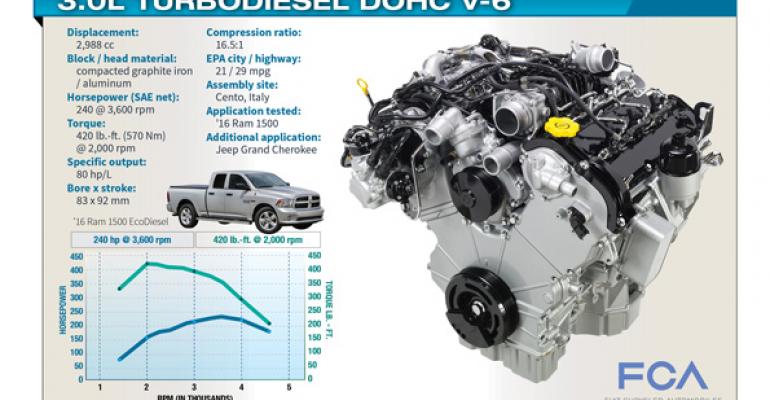Diesel engines have been in the news a lot the past year, but for all the wrong reasons. As we know, Volkswagen was caught cheating on the emissions of its popular passenger-car diesels.
The aftermath of that has been an ongoing legal, financial and public relations disaster for VW and a black eye for diesels, especially in the U.S. where, unlike Europe, car and CUV diesels have only niche-market status. VW’s global brand chief recently said the brand no longer will offer diesel vehicles in the U.S.
Scandal aside, while diesels offer significant torque and efficiency advantages over gasoline engines, the fact they clatter when cold, vibrate more at idle and require expensive exhaust aftertreatment systems limits their appeal to U.S. car buyers.
But bigger diesel engines remain the engine of choice for heavy-duty pickups and commercial-vehicles because of their torque superiority and better-than-gas efficiency towing and hauling heavy loads.
Now, thanks to FCA’s 3.0L V-6 EcoDiesel in the Ram 1500 and GM’s 2.8L 4-cyl. Duramax in the Chevrolet Colorado and GMC Canyon, diesels are carving out a new niche in light-duty pickups that has gone unscathed by the VW controversy, despite hefty price premiums ($4,770 in the Ram 1500).
“For certain products, that’s what you need to do the work, says FCA’s Bob Lee, vice president-Global Powertrain. “If you want to tow a large boat or work with construction equipment, diesel is the most efficient.”
FCA’s 60-degree V-6 EcoDiesel works so well in the Ram 1500, and offers such gas-engine-like quietness and refinement, it has won a Wards 10 Best Engine trophy for three straight years since its debut as a ’14 model.
It has a compacted graphite iron block, aluminum heads, dual chain-driven overhead camshafts, 24 valves and a 29,000 psi (2,000-bar) common-rail fuel-injection system with solenoid injectors. In the ’16 Ram 1500 quad-cab RWD pickup tested by WardsAuto editors, it generates 240 hp at 3,600 rpm and a very healthy 420 lb.-ft. (570 Nm) of peak torque at 2,000 rpm. Yet it is rated at 21/29 mpg (11.2-8.1 L/100 km) highway and 24 mpg (9.8 L/100 km) combined, impressive for a fullsize pickup.
A key contributor to the Ecodiesel’s performance and refinement, as well as its emissions compliance, is a multi-pulse injection concept Fiat developed some years ago. Small “pilot” injections of fuel before the main injection create a better air-fuel mixture for more efficient combustion and lower emissions. Then post-combustion spritzes send fuel through the exhaust system to create bursts of heat that clean the diesel particulate filter. As a side benefit, using multiple shorter, smaller injections also reduces diesel clatter.
The engine’s most noticeable upgrade for 2016 is better part-load responsiveness, which has improved its launch time 30% and its initial acceleration. “Diesel engines require a careful balance between gaseous and particulate tailpipe emissions, fuel economy, NVH and drivability over a wide range of ambient temperatures and altitude,” Lee says, “and we worked diligently to attain performance-feel improvements while ensuring no discernible degradation in other characteristics.”
How was that accomplished? “The EcoDiesel’s variable geometry turbocharger and the multiple-injection capability of Multi-Jet II technology are the most significant contributors, because they afford greater control over air and fuel management. Multi-Jet II utilizes high-dispersion nozzles that can accommodate up to eight injection events per combustion cycle.”
It also required additional fine-tuning of its engine management controls. “Electronic controls are among the most powerful tools we have to achieve performance gains,” Lee says. “We developed new control strategies to shape torque in response to all the relevant inputs – pedal, transmission, engine and vehicle speed. This also required us to introduce new combustion controls to maintain emissions compliance and preserve our fuel-economy leadership.”
The engine was developed in 2008-2009 by Italy’s VM Motori (which FCA now owns) and has served well in European-market Jeep Grand Cherokees, Chrysler 300Cs (known there as Lancia Themas) and even some Maserati sedans. Other key contributors to its quietness are its highly rigid CGI block and bedplate. CGI is a stronger, denser form of iron that typically reduces combustion noise 0.5 to 1.5 dBA compared with conventional gray iron.
And while that construction helped its suitability for North American applications, its control calibration, combustion and fuel-injection characteristics were tweaked to further improve NVH for U.S. and Canadian customers accustomed to smooth, quiet gasoline power.
Beyond taming its acoustic personality, the toughest challenge in bringing the diesel to North America was certifying both its emissions and its on-board diagnostic systems for tougher U.S. rules. Meeting today’s and tomorrow’s squeaky-clean U.S. emissions standards requires the highly complex aftertreatment combination of a diesel oxidation catalyst, a diesel particulate filter and selective catalyst reduction, a system that needs a lot more sensors and controls than current European versions, at least for now.
Comparing it to GM’s smaller 2.8L Duramax 4-cylinder turbodiesel and the larger Cummins 5.0L V-8 available in Nissan’s Titan XD pickup, WardsAuto judges (in Three Bears nursery rhyme style) declared the first “too small,” the second “too big,” both noticeably noisier, and the 3.0L Ecodiesel V-6 “ideally sized, “amazingly quiet” and “just right” in size. They also called it highly flexible, as evidenced by its use in some European Maseratis, and “well-suited for towing lots of things.” And in their 10 days of testing it in a Ram 1500 pickup, they saw observed fuel economy approaching 24 mpg (9.8 L/100 km).
“This 3.0L continues to impress us with ideal measures of power, torque, refinement and luxury-car smoothness,” they concluded.
Is there room for further improvement as customer and CAFE demands ramp up each year? “There is certainly room for improvement,” Lee responds. “There always is. As engineers, we can’t change the laws of physics, but we can find new ways of improving the engine hardware, aftertreatment system, lubricants and electronic controls.”





